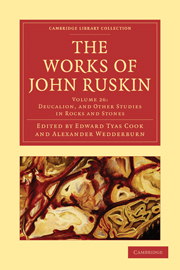Book contents
- Frontmatter
- Contents
- LIST OF ILLUSTRATIONS
- INTRODUCTION TO THIS VOLUME
- I ON THE FORMS OF THE STRATIFIED ALPS OF SAVOY (1863)
- II NOTES ON THE SHAPE AND STRUCTURE OF SOME PARTS OF THE ALPS, WITH REFERENCE TO DENUDATION (1865)
- III ON BANDED AND BRECCIATED CONCRETIONS (1867–1870)
- IV DEUCALION: COLLECTED STUDIES OF THE LAPSE OF WAVES AND LIFE OF STONES (1875–1883)
- V ON THE DISTINCTIONS OF FORM IN SILICA (1884)
- VI CATALOGUES OF MINERALS
- VII THE GRAMMAR OF SILICA (not hitherto published)
- APPENDIX: LETTERS, ADDRESSES, AND NOTES
- I NOTICE RESPECTING SOME ARTIFICIAL SECTIONS ILLUSTRATING THE GEOLOGY OF CHAMOUNI (1858)
- II LETTERS TO THE “READER” ON THE CONFORMATION OF THE ALPS (1864)
- III JAMES DAVID FORBES (1874)
- IV A LECTURE ON STONES (1876)
- V THE ALPINE CLUB AND THE GLACIERS (1878)
- VI INTRODUCTION TO W. G. COLLINGWOOD'S “LIMESTONE ALPS OF SAVOY” (1884)
- VII THE GARNET (1885)
- VIII A GEOLOGICAL RAMBLE IN SWITZERLAND
- INDEX
- Plate section
IV - A LECTURE ON STONES (1876)
Published online by Cambridge University Press: 05 March 2012
- Frontmatter
- Contents
- LIST OF ILLUSTRATIONS
- INTRODUCTION TO THIS VOLUME
- I ON THE FORMS OF THE STRATIFIED ALPS OF SAVOY (1863)
- II NOTES ON THE SHAPE AND STRUCTURE OF SOME PARTS OF THE ALPS, WITH REFERENCE TO DENUDATION (1865)
- III ON BANDED AND BRECCIATED CONCRETIONS (1867–1870)
- IV DEUCALION: COLLECTED STUDIES OF THE LAPSE OF WAVES AND LIFE OF STONES (1875–1883)
- V ON THE DISTINCTIONS OF FORM IN SILICA (1884)
- VI CATALOGUES OF MINERALS
- VII THE GRAMMAR OF SILICA (not hitherto published)
- APPENDIX: LETTERS, ADDRESSES, AND NOTES
- I NOTICE RESPECTING SOME ARTIFICIAL SECTIONS ILLUSTRATING THE GEOLOGY OF CHAMOUNI (1858)
- II LETTERS TO THE “READER” ON THE CONFORMATION OF THE ALPS (1864)
- III JAMES DAVID FORBES (1874)
- IV A LECTURE ON STONES (1876)
- V THE ALPINE CLUB AND THE GLACIERS (1878)
- VI INTRODUCTION TO W. G. COLLINGWOOD'S “LIMESTONE ALPS OF SAVOY” (1884)
- VII THE GARNET (1885)
- VIII A GEOLOGICAL RAMBLE IN SWITZERLAND
- INDEX
- Plate section
Summary
On commencing, Mr. Ruskin at once put himself on good terms with his audience by a few friendly words, and then introduced his subject by calling attention to a sovereign and a pebble. Of the first, he remarked that he knew, to some extent, what a pound would do, and what it was good for, but there was much to be learnt about the sovereign which very few people were acquainted with. For instance, it had stamped on it a man on a flying horse, stabbing at an impossible dragon in a manner in which it would be impossible to kill him. They called the man St. George, but people did not know much about St. George, or why he should be on the sovereign. Then as to the pebble, any apothecary could tell them of what it was made, and, for that matter, could tell, too, what the lecturer and his hearers were made of; but in doing so, he would not tell them what a boy or man was, and still less what such an inexplicable thing as a girl or a woman was. To know what a thing was, they must know what it could do and what it was good for.
They knew that a piece of flint, when struck by steel, would produce fire, but there was more to be learned about it than that. In some places it fortified the cliffs of England, and on the very brow of that cliff the flints were taken up in the softest form by the grasses that grew there. This had been examined by one of his pupils—a student at Oxford, who had taken the stalk of a particular kind of grass, and had, by subjecting it to the influence of an acid, obtained pure flint—the fact being, that there was not a bit of grass grown that did not make its skeleton of flint, just as human beings' bones were built up of lime.
- Type
- Chapter
- Information
- The Works of John Ruskin , pp. 563 - 565Publisher: Cambridge University PressPrint publication year: 2010First published in: 1906



